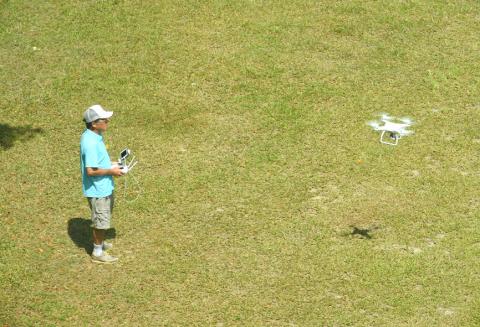The Taichung City Government is planning to ban drones in two public areas — the Calligraphy Greenway and Citizen Plaza — later this month in a bid to prevent injury from drone collisions or malfunctioning machines.
The city’s Construction Bureau said that as the devices are growing in popularity and more people are using them in public spaces during holidays, there is a risk to people and property from drones colliding and crashing to the ground.
Residents in buildings around the plaza and greenway have expressed concern about the camera-equipped devices encroaching on their privacy, the bureau said.

Photo: Chang Chia-ming, Taipei
There is also the risk of signal interference as drone usage grows, causing loss of control over the devices and potential accidents, the bureau added.
It cited as examples a drone crashing into the Taipei 101 skyscraper in July last year; a drone falling and injuring a woman at Sun Moon Lake in June; and another one crashing into the High Speed Rail tracks in Hsinchu.
“Using drones can be dangerous and there is still no government agency tasked with regulating their usage. This is especially problematic given that the machines can be purchased online for as little as NT$50,000 to NT$60,000. The low cost of drones means that they can now be seen flying everywhere, spreading with no resistance,” said a bureau official, who declined to be named.
The bureau said that public safety and environmental protection are its main concerns, and it aims to prevent an incident before one occurs.
It added that in accordance with public interests, it will invoke Item 11.2 of Clause 99 of the Civil Aviation Act (民航法) to prohibit the operation of drones in prohibited and restricted areas.
Calligraphy Greenway and Citizen Plaza will be designated as two of these restricted areas under the city’s park ordinance, the bureau said, adding that signs will be posted and an announcement made before the new restrictions take effect later this month.
No exact date was given.

Taiwan is to commence mass production of the Tien Kung (天弓, “Sky Bow”) III, IV and V missiles by the second quarter of this year if the legislature approves the government’s NT$1.25 trillion (US$39.78 billion) special defense budget, an official said yesterday. Commenting on condition of anonymity, a defense official with knowledge of the matter said that the advanced systems are expected to provide crucial capabilities against ballistic and cruise missiles for the proposed “T-Dome,” an advanced, multi-layered air defense network. The Tien Kung III is an air defense missile with a maximum interception altitude of 35km. The Tien Kung IV and V

The disruption of 941 flights in and out of Taiwan due to China’s large-scale military exercises was no accident, but rather the result of a “quasi-blockade” used to simulate creating the air and sea routes needed for an amphibious landing, a military expert said. The disruptions occurred on Tuesday and lasted about 10 hours as China conducted live-fire drills in the Taiwan Strait. The Civil Aviation Administration (CAA) said the exercises affected 857 international flights and 84 domestic flights, affecting more than 100,000 travelers. Su Tzu-yun (蘇紫雲), a research fellow at the government-sponsored Institute for National Defense and Security Research, said the air

A strong continental cold air mass is to bring pollutants to Taiwan from tomorrow, the Ministry of Environment said today, as it issued an “orange” air quality alert for most of the country. All of Taiwan except for Hualien and Taitung counties is to be under an “orange” air quality alert tomorrow, indicating air quality that is unhealthy for sensitive groups. In China, areas from Shandong to Shanghai have been enveloped in haze since Saturday, the ministry said in a news release. Yesterday, hourly concentrations of PM2.5 in these areas ranged from 65 to 160 micrograms per cubic meter (mg/m³), and pollutants were

Taiwan’s armed forces have established response protocols for a wide range of sudden contingencies, including the “Wan Chun Plan” to protect the head of state, the Ministry of Defense (MND) said today. After US President Donald Trump on Saturday launched a series of airstrikes in Venezuela and kidnapped Venezuelan President Nicolas Maduro, concerns have been raised as to whether China would launch a similar “decapitation strike” on Taiwan. The armed forces regularly coordinate with relevant agencies and practice drills to ensure preparedness for a wide range of scenarios, Vice Minister of National Defense Hsu Szu-chien (徐斯儉) told reporters before a